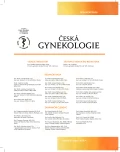Technique of pelvic and paraaortic lymphadenectomy
Authors:
J. Sláma; R. Kocián
Authors‘ workplace:
Gynekologicko-porodniká klinika VFN a 1. LF UK, Praha, přednosta prof. MUDr. A. Martan, DrSc.
Published in:
Ceska Gynekol 2016; 81(4): 253-264
Overview
Objective:
Overview of classification, anatomical conditions, methods and complications of pelvic and paraaortic lymph-node dissection.
Design:
Review article.
Setting:
Department of Obstetrics and Gynecology, General Faculty Hospital and 1st Medical Faculty, Charles University, Prague.
Materials and methods:
Lymphadenectomy is classified according to its extent into sentinel lymph-node biopsy, debulking, sampling and systematic procedure and according to approach into extraperitoneal or transperitoneal procedure. The most complex variant is systematic pelvic and paraaortic lymph-node dissection, which requires removal of fatty-lymphatic tissue from anatomically strictly defined areas. Procedure can be performed from laparotomy, laparoscopically or robotically.
Results:
The main objective criterium of systematic procedure is the number of harvested nodes. The most common complications comprise bleeding and lymphocele formation.
Conclusions:
Pelvic and paraaortic lymphadenectomy represent basic component of surgical management in majority of gynecological cancers. The knowledge of extent, different techniques and ability to solve complications represents essential skill in gynecological oncology.
Keywords:
sentinel lymph-node biopsy, pelvic lymphadenectomy, paraaortic lymphadenectomy, debulking
Sources
1. Benedetti-Panici, P., Maneschi, F., Scambia, G., et al. Lymphatic spread of cervical cancer: An anatomical and pathological study based on 226 radical hysterectomies with systematic pelvic and aortic lymphadenectomy. Gynecol Oncol, 1996, 62, p. 19–24.
2. Benedetti-Panici, P., Scambia, G., Baiocchi, G., et al. Technique and feasibility of radical para-aortic and pelvic lymphadenectomy for gynecologic malignancies: a prospective study. Int J Gynecol Cancer, 1991, 1, p. 133–140.
3. Cibula, D., Abu-Rustum, NR. Pelvic lymphadenectomy in cervical cancer – surgical anatomy and proposal for a new classification system. Gynecol Oncol, 2010, 116, p. 33–37.
4. Cibula, D., Abu-Rustum, NR., Dusek, L., et al. Bilateral ultrastaging of sentinel lymph node in cervical cancer: Lowering the false-negative rate and improving the detection of micrometastasis. Gynecol Oncol, 2012, 127, p. 462–466.
5. Euscher, ED., Malpica, A., Atkinson, EN., et al. Ultrastaging improves detection of metastases in sentinel lymph nodes of uterine cervix squamous cell carcinoma. Am J Surg Pathol, 2008, 32, p. 1336–1343.
6. Gortzak-Uzan, L., Jimenez, W., Nofech-Mozes, S., et al. Sentinel node biopsy vs. pelvic lymphadenctomy in early stage cervical cancer: Is it time to change the gold standard? Gynecol Oncol, 2010, 116, p. 28–32.
7. Halaska, MJ., Novackova, M., Mala, I., et al. A prospective study of postoperative lymphedema after surgery for cervical cancer. Int J Gynecol Cancer, 2010, 20, p. 900–904.
8. Huang, M., Slomovitz, BM., Ramirez, PT. Transperitoneal versus extraperitoneal para-aortic lymphadenctomy in patients with cervical cancer. Rev Obstet Gynecol, 2009, 2, p. 101–106.
9. Levenback, CF., van der Zee, AGJ., Rob, L., et al. Sentinel lymph node biopsy in patients with gynecologic cancers. Expert panel statement from the International Sentinel Node Meeting, February 21, 2008. Gynecol Oncol, 2009, 114, p. 151–156.
10. Querleu, D., Dargent, D., Ansquer, Y., et al. Extraperitoneal endosurgical aortic and common iliac dissection in the staging of bulky or advanced cervical carcinomas. Cancer, 2000, 88, p. 1883–1891.
11. Querleu, D., Ferron, G., Rafii, A., et al. Pelvic lymph node dissection via a lateral extraperitoneal approach: Description of a technique. Gynecol Oncol, 2008, 109, p. 81–85.
12. Slama, J., Dundr, P., Dusek, L., et al. Sentinel lymph node status in patients with locally advanced cervical cancers and impact of neoadjuvant chemotherapy. Gynecol Oncol, 2012, 125, p. 303–306.
13. Zivanovic, O., Sheinfield, J., Abu-Rustum, NR. Retroperitoneal lymph node dissection (RLND). Gynecol Oncol, 2008, 111, p. S66–S69.
14. Zikan, M., Fischerova, D., Pinkavova, I., et al. A prospective study examining the incidence of asymptomatic and symptomatic lymphoceles following lymphadenectomy in patients with gynecological cancer. Gynecol Oncol, 2015, 137, p. 291–298.
Labels
Paediatric gynaecology Gynaecology and obstetrics Reproduction medicineArticle was published in
Czech Gynaecology

2016 Issue 4
Most read in this issue
- Technique of pelvic and paraaortic lymphadenectomy
- Prague 1337: the first successful caesarean section in which both mother and child survived may have occurred in the court of John of Luxembourg, King of Bohemia
- Present properties of ultrasound diagnostics in urogynecology
- Fetal alloimmune thrombocytopenia in pregnant woman with anti-HPA-1a antibodies
